POE Switches have become the backbone of modern technology. These switches are revolutionizing the way organizations connect devices across their networks.
By allowing both (power and data) to be transmitted over a single Ethernet cable, PoE switches simplify installations.
Also, it reduces the need for additional power infrastructure.
However, while PoE switches offer many advantages, they also come with a few drawbacks.

What Is a PoE Switch?
A PoE switch is a networking device that delivers electrical power and data to connected devices through an Ethernet cable.
It is generally known as power over ethernet switch.
This eliminates the need for separate power supplies. It will make it easier to install and power devices such as IP cameras, VoIP phones etc.
PoE switches are particularly useful in locations where power outlets are hard to reach or costly.
However, like any technology, PoE switches have their pros and cons.
Advantages of PoE Switches:
- PoE switches allow both data and power to be transmitted over a single Ethernet cable, reducing the need for separate power outlets and wiring.
- By eliminating the need for additional electrical wiring, PoE switches help lower both material and labor costs. This makes them a budget-friendly option for large installations.
- Since devices don’t need to be located near power outlets, they can be placed in more strategic locations, even in remote or difficult-to-reach areas.
- PoE switches offer the ability to control power remotely. Network administrators can monitor and control devices from a central location. In a simple word, it makes troubleshooting and power cycling more convenient.
- As your network grows, PoE switches make it easy to add more devices without the need for additional power infrastructure. This scalability ensures that your network can expand with minimal effort.
Disadvantages of PoE Switches:
- Standard PoE delivers up to 15.4 watts, and PoE+ provides up to 30 watts. While sufficient for many devices, some high-power devices like PTZ cameras or multiple-radio wireless access points may require more power than PoE can provide.
- PoE-enabled switches are typically more expensive upfront compared to non-PoE switches. The cost can add up when upgrading an existing network to support PoE.
- PoE switches generate more heat due to the added power load. In poorly ventilated environments, this can reduce the lifespan of devices. Also, it can cause performance issues.
- PoE has a maximum transmission range of 100 meters. Beyond this, the power and data signal degrade. Additional equipment like PoE extenders or repeaters may be needed for longer distances.
- A failure in the PoE switch can lead to a loss of both power and connectivity for all connected devices. This makes the switch a single point of failure, which can be mitigated by using uninterruptible power supplies (UPS).
In a simple word, PoE switches offer a convenient, scalable, and cost-effective solution for powering network devices, especially in large or remote installations.
They simplify the installation process, reduce wiring complexity, and provide centralized control for easier network management.
However, potential limitations such as power constraints, heat generation, and distance limits should be considered before integrating PoE technology into your network.
By understanding these pros and cons, you can make a more informed decision on whether PoE switches are the right fit for your networking needs.
